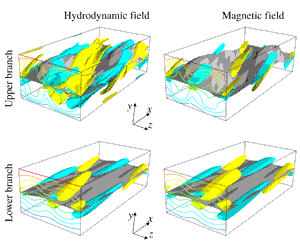Article contents
Subcritical magnetohydrodynamic instabilities: Chandrasekhar’s theorem revisited
Published online by Cambridge University Press: 11 November 2019
Abstract

Subcritical instabilities (i.e. finite-amplitude instabilities that occur without any linear instability) in magnetohydrodynamic (MHD) flows are studied by computing finite-amplitude equilibrium solutions of viscous–resistive MHD equations. The plane Couette flow magnetised by a uniform spanwise current is used as a model flow. Solutions are found for broad sub- and super-Alfvénic flow regimes by controlling the magnetic Mach number, but their existence is greatly influenced by the magnetic Prandtl number. When that number is unity, and the walls are perfectly insulating, the solution branch found in the super-Alfvénic regime cannot be continued towards the sub-Alfvénic regime; the boundary between those regimes is called the Chandrasekhar state, where Chandrasekhar (Proc. Natl Acad. Sci. USA, vol. 42, 1956, pp. 273–276) proved the non-existence of a linear ideal instability. Thus, the result may seem to suggest that the Chandrasekhar theorem holds even when diffusivity and nonlinearity are present. This is certainly true, but only when the perturbation magnetic field on the boundary is small. The boundary effects add more complexity to the nonlinear analysis of the Chandrasekhar state. The Chandrasekhar theorem is known to work for flows bounded by perfectly conducting walls. However, somewhat paradoxically, when the walls are perfectly conducting, our large-Reynolds-number computational results show that the nonlinear solutions do exist in the Chandrasekhar state. We give a theoretical reasoning for this curious phenomenon, using a large-Reynolds-number asymptotic analysis. For small magnetic Prandtl numbers, we also show that the solution can be continued for infinitesimally small magnetic Mach number, where the flow is significantly sub-Alfvénic.
JFM classification
- Type
- JFM Papers
- Information
- Copyright
- © 2019 Cambridge University Press
References
- 2
- Cited by




